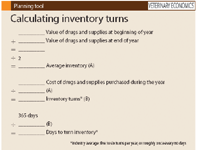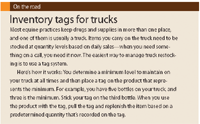Harness your inventory
Carrying too much inventory can hurt your practice's bottom line.
If you can control a horse in the stall, why are you letting inventory problems run roughshod all over you? Keeping too much inventory in your practice or vehicle drains money right out of your bank account. The rule of thumb is that each extra $100 of inventory you keep on hand over the course of a year costs your practice a total of $8 in stocking and carrying. That's not chump change. It's time to use some simple calculations and your practice software to corral these inventory costs. I'll show you how.
Figure the right amount
How do you determine how much product to keep on hand? Look at your annual drug and supply purchases and divide that number by your inventory turns—the number of times in a year you go through your entire inventory and restock it. Most equine practitioners average five to six inventory turns per year, which means they use their entire inventory every 60 days, roughly. Let's say you spend $90,000 on drugs and supplies per year. If you use an average inventory turn ratio of 5.5 (halfway between the industry average of five and six), then the dollar amount of inventory you should maintain is $16,364 ($90,000 ÷ 5.5).
To compare your inventory turns to the industry standard, tally up the value of your inventory at the beginning and end of the year. Remember to include the drugs you hold for resale and the supplies you need for services. Add those numbers together and divide by two: that's your average inventory. Divide the total cost of your yearly drug purchases by that number. The result is your inventory turn ratio.
For example, let's say you take physical inventories at the beginning and end of the year and find that your average inventory is $26,895. Your yearly drug and supply purchases come to $90,000. Thus, your inventory turns over 3.35 times ($90,000 ÷ $26,895). That's low; it should turn over between five and six times, as we learned earlier. If you divide 365 days by your inventory turns (365 ÷ 3.35), you'll learn that your inventory turns once every 109 days. That's not quick enough—you're aiming for roughly every 60 days. You're almost guaranteed not to run out of anything with so much sitting inventory, but you're racking up needless carrying costs, possibly more than $800 over the course of a year.
To calculate your practice's inventory turns, use the formula at right, see the Related Links below for an interactive Excel spreadsheet, or search for "inventory calculation worksheet."

Planning tool: Click to enlarge
Set up a system
You may now realize—or suspect—that your inventory turns are off the mark. So what do you do about it? Enlist your software to help. Generic accounting programs such as QuickBooks possess a few functions for controlling inventory with invoicing, but they don't match what's available in veterinary-specific practice software. If you're like many equine practitioners, you're already using your software to keep track of client records, invoicing, and reminders, but you're not necessarily using the available inventory module. It's time to start.
Use this software to keep track of the vendors you use, the last price you paid on particular products, and the standard markup you're using to set the price you charge clients. You can also keep track of dispensing fees for each product and minimum prescription prices. More advanced features let you set economic reorder points and input the quantities you need to keep on hand, with alerts that let you know when an amount drops below that level. Automation is the easiest way to control your systems for ordering and using drugs and supplies.
Decide when to buy
Now let's explore the basics of placing orders. How much should you reorder and when? First, look at your sales patterns using your practice software. How much on average do you sell of any item on a daily basis? Order only as much as you'll need in a typical cycle. If you're considering larger purchase orders than you'll use in a reasonable time (remember that magic number of 60 days), look for discounts and make sure they're large enough to cover the cost of overstocking. A six-month supply order to save 3 percent isn't worth it. For example, if your normal ordering cycle is once every two weeks and you sell four bottles of a particular drug per day, then when you place your next biweekly order, request 56 bottles (four bottles a day X 14 days).
You also need to decide the minimum amount of stock to keep on hand at all times. The minimum quantity of a drug you keep on hand is based on how much of it you sell every day and the time it takes for an order to arrive. So if you sell four bottles of a drug every day and it takes three days for the drug to come in, you don't ever want to drop below 12 bottles (four bottles sold per day X three days' shipping) or you risk running out. If you put these minimums into your practice software, you can print a "want list" of items that have dropped below the minimum quantities. Make this list a part of the routine ordering process. These minimums may change seasonally, so be sure to include that information in your software and inventory planning.
Determine what to charge
You compete heavily for product sales with the Internet and catalogs, but that doesn't mean you're completely out of the game. There are certain items you must keep on hand for farm calls and other situations where you prescribe and deliver drugs and other products on site. Charge normal markups and dispensing fees for these items, and also set minimum prescription prices.
Dispensing fees, which range from $4 to $8 in equine practice today, are important because they cover the cost of labor and repackaging to get the prescription to the client. These costs cannot be covered with a normal markup. For items that you count and label, a minimum prescription price covers your time and effort in dispensing low quantities. Typical minimum prescription prices in equine practices range from $8 to $12.
Watch the system
The inventory process should be a daily part of your practice life. Even if you're using your software's inventory capabilities, you need to establish a manual verification process to make sure the quantities in your practice match the quantities reported in the software. To do this, consider performing cycle counts. In a cycle count, you break up the counting of your entire inventory into a certain number of items per day so that you count all of your drugs and supplies every 60 days. When you're done, you start all over again.

To get started, develop a set of daily inventory sheets listing the items to be counted and space to record the quantities on hand. Divide your total list of inventory items onto the daily sheets so that you've counted everything in 60 days. If certain items turn more often, you may want to count them more frequently. Compare the quantities on the sheets with the quantities in the software system, and investigate any discrepancies. A system with built-in inventory checks and balances not only verifies accuracy, it also keeps employees honest—they know you'll notice when something can't be accounted for.
There are a lot of boxes and bottles in equine practice, and it's easy to lose sight of some of them. But the money you spent on products that rattled around in your truck for six months should be in your wallet right now. You need a good inventory system to keep tabs on your products and supplies, to ensure that you're carrying the right amount at all times, and to charge clients correctly. It's time to show that bucking bronco of drugs and supplies who's boss around here.

On the road
Veterinary Economics Editorial Advisory Board member Gary Glassman, CPA, is a partner with Burzenski and Co. in East Haven, Conn. Send comments to ve@advanstar.com.